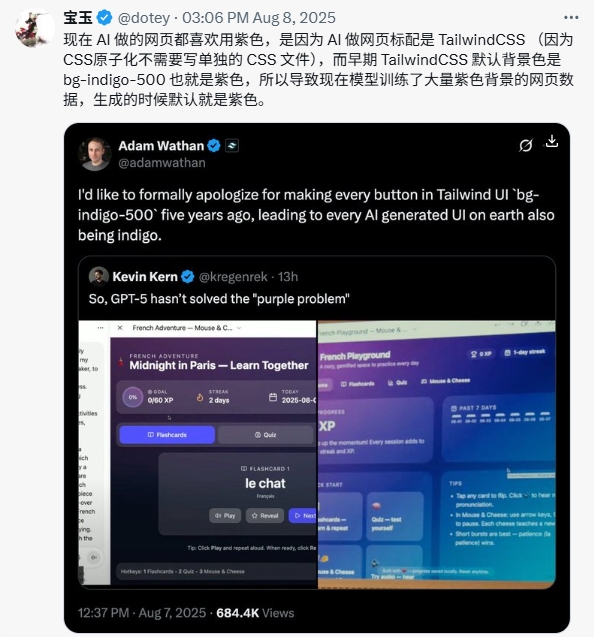AI's Purple Preference: How a CSS Choice Shaped Design Trends
AI's Unexpected Purple Obsession: Tracing the Color Trend
August 7, 2025 - A casual tweet by Tailwind CSS co-founder Adam Wathan sparked widespread discussion about AI design preferences. His apology for using bg-indigo-500 as a default button color five years ago revealed an unexpected consequence: most AI-generated interfaces now feature purple elements.

The Evidence Mounts
Developer Kevin Kern provided concrete evidence by sharing screenshots of "French Playground," an AI-generated language learning app dominated by purple buttons and themes. His observation that "GPT-5 hasn't solved the 'purple problem' yet" resonated across tech circles.

Technical Roots of the Phenomenon
Analysis by user @dotey identified the core issue:
"AI defaults to using Tailwind CSS for web design because atomic CSS doesn't require separate CSS files."
The framework's predictable class names (bg-indigo-500, text-white, p-4) made it ideal for AI tools to process, but created an unintended bias.

The Self-Reinforcing Cycle
- Initial Bias: Early adoption of Tailwind's purple defaults
- Data Contamination: These designs entered training datasets
- Pattern Entrenchment: AI learned to associate modern interfaces with purple
- Cycle Reinforcement: New purple designs further skewed future training data
Community Reactions Divided
The discovery prompted varied responses:
- The Confused: Many developers assumed purple was a conscious design choice
- The Amused: Some found humor in the accidental trend
- The Analytical: Noted purple's psychological associations with creativity and technology
Implications for AI Development
The phenomenon highlights critical challenges:
- Design Homogenization Risk: Overused color schemes threaten brand differentiation
- Training Data Quality: Limited frameworks create narrow output patterns
- Innovation Barriers: AI replicates rather than innovates on design concepts
Potential Solutions:
| Short-Term | Long-Term |
|---|
:
- Unexpected Legacy: A minor CSS decision created widespread design impact through AI amplification
- Data Bias Danger: Training sets must represent diverse sources to prevent homogenization
- Psychological Fit: Purple's tech associations make the trend somewhat functional despite its accidental origins
- Developer Awareness: Understanding these patterns helps create better guardrails for AI tools
- Future Outlook: Next-gen models may overcome this limitation with more balanced training approaches